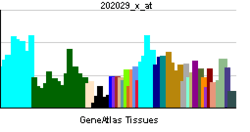60S ribosomal protein L38
| View/Edit Human | View/Edit Mouse |
60S ribosomal protein L38 is a protein that in humans is encoded by the RPL38 gene.[3][4]
Gene
The human RPL38 gene resides on the long arm of chromosome 17 at 17q25.1. It consists of five exons spread out over a distance of 6223 bp. The 213 nucleotide open reading frame encodes a 70 amino acid protein. Alternative splice variants have been identified, both encoding the same protein. As is typical for genes encoding ribosomal proteins, there are multiple processed pseudogenes of this gene dispersed through the genome, including one located in the promoter region of the angiotensin II receptor type 1 gene.[4]
Function
Ribosomes, the organelles that catalyze protein synthesis, consist of a small 40S subunit and a large 60S subunit. Together these subunits are composed of 4 RNA species and approximately 80 structurally distinct proteins. This gene encodes a ribosomal protein that is a component of the 60S subunit. The protein belongs to the L38E family of ribosomal proteins. It is located in the cytoplasm.[4]
Genetics
An ~18kbp deletion, encompassing the entire Rpl38 locus underlies the phenotype in the Tail-short (Ts) mutant mouse. In homozygous state, Ts mice die at around 3–4 days of gestation. Ts/+ heterozygous embryos undergo an anemia and develop skeletal malformations. During the perinatal period ~30% of the heterozygotes die. The surviving heterozygous Ts exhibit great variations of shortened, kinked and otherwise malformed tails.[5] They also weigh less than their wild-type littermates but have otherwise a normal life span. Additionally, Ts mice develop a conductive hearing loss shortly after the onset of hearing at around 3–4 weeks of age. The hearing loss is the result of ectopic ossification along the round window ridge at the outside of the cochlea, massive deposition of cholesterol crystals in the middle ear cavity, an enlarged Eustachian tube and a chronic otitis media with effusion.[6]
In Drosophila melanogaster, loss-of-function alleles of RPL38, cause embryonic lethality in homozygotes and protracted growth and shortened bristles in heterozygotes. Due to the haplo-insufficient nature of the mutation, the phenotype is inherited as a dominant trait.[7]
In humans, mutations in ribosomal proteins cause Diamond-Blackfan Anemia. However, no disease has yet been linked to mutations in human RPL38.
References
- ↑ "Human PubMed Reference:".
- ↑ "Mouse PubMed Reference:".
- ↑ Kenmochi N, Kawaguchi T, Rozen S, Davis E, Goodman N, Hudson TJ, Tanaka T, Page DC (Aug 1998). "A map of 75 human ribosomal protein genes". Genome Res. 8 (5): 509–23. doi:10.1101/gr.8.5.509. PMID 9582194.
- 1 2 3 "Entrez Gene: RPL38 ribosomal protein L38".
- ↑ Morgan, WC (1950). "A new tail-short mutation in the mouse whose lethal effects are conditioned by the residual genotypes". The Journal of heredity. 41 (8): 208–15. PMID 14779008.
- ↑ Noben-Trauth K, Latoche JR (January 2011). "Ectopic Mineralization in the Middle Ear and Chronic Otitis Media with Effusion Caused by RPL38 Deficiency in the Tail-short (Ts) Mouse". J. Biol. Chem. 286 (4): 3079–3093. doi:10.1074/jbc.M110.184598. PMC 3024801
 . PMID 21062742.
. PMID 21062742. - ↑ Marygold, S. J.; Coelho, C.; Leevers, S. (2005). "Genetic Analysis of RpL38 and RpL5, Two Minute Genes Located in the Centric Heterochromatin of Chromosome 2 of Drosophila melanogaster". Genetics. 169 (2): 683–695. doi:10.1534/genetics.104.034124. PMC 1449105
 . PMID 15520262.
. PMID 15520262.
External links
- Human RPL38 genome location and RPL38 gene details page in the UCSC Genome Browser.
Further reading
- Wool IG, Chan YL, Glück A (1996). "Structure and evolution of mammalian ribosomal proteins". Biochem. Cell Biol. 73 (11–12): 933–947. doi:10.1139/o95-101. PMID 8722009.
- Espinosa L, Martín M, Nicolas A, et al. (1997). "Primary sequence of the human, lysine-rich, ribosomal protein RPL38 and detection of an unusual RPL38 processed pseudogene in the promoter region of the type-1 angiotensin II receptor gene". Biochim. Biophys. Acta. 1354 (1): 58–64. doi:10.1016/s0167-4781(97)00124-3. PMID 9375793.
- Uechi T, Tanaka T, Kenmochi N (2001). "A complete map of the human ribosomal protein genes: assignment of 80 genes to the cytogenetic map and implications for human disorders". Genomics. 72 (3): 223–230. doi:10.1006/geno.2000.6470. PMID 11401437.
- Yoshihama M, Uechi T, Asakawa S, et al. (2002). "The human ribosomal protein genes: sequencing and comparative analysis of 73 genes". Genome Res. 12 (3): 379–390. doi:10.1101/gr.214202. PMC 155282
 . PMID 11875025.
. PMID 11875025. - Strausberg RL, Feingold EA, Grouse LH, et al. (2003). "Generation and initial analysis of more than 15,000 full-length human and mouse cDNA sequences". Proc. Natl. Acad. Sci. U.S.A. 99 (26): 16899–16903. doi:10.1073/pnas.242603899. PMC 139241
 . PMID 12477932.
. PMID 12477932. - Bouwmeester T, Bauch A, Ruffner H, et al. (2004). "A physical and functional map of the human TNF-alpha/NF-kappa B signal transduction pathway". Nat. Cell Biol. 6 (2): 97–105. doi:10.1038/ncb1086. PMID 14743216.
- Gerhard DS, Wagner L, Feingold EA, et al. (2004). "The status, quality, and expansion of the NIH full-length cDNA project: the Mammalian Gene Collection (MGC)". Genome Res. 14 (10B): 2121–2127. doi:10.1101/gr.2596504. PMC 528928
 . PMID 15489334.
. PMID 15489334. - Tsang HT, Connell JW, Brown SE, et al. (2006). "A systematic analysis of human CHMP protein interactions: additional MIT domain-containing proteins bind to multiple components of the human ESCRT III complex". Genomics. 88 (3): 333–346. doi:10.1016/j.ygeno.2006.04.003. PMID 16730941.
- Ewing RM, Chu P, Elisma F, et al. (2007). "Large-scale mapping of human protein-protein interactions by mass spectrometry". Mol. Syst. Biol. 3 (1): 89. doi:10.1038/msb4100134. PMC 1847948
 . PMID 17353931.
. PMID 17353931.
